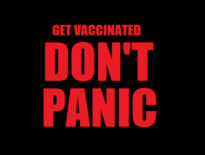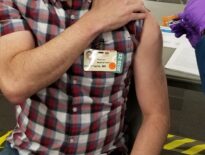Wednesday, March 17, 2021

It’s been a long dark night
And I’ve been a waitin’ for the morning
It’s been a long hard fight
But I see a brand new day a dawning
— Dolly Parton, Light of a Clear Blue Morning
In medicine, the light at the end of the tunnel is usually the colonoscope, but this time, of course, I’m speaking metaphorically. After a year of death, sickness, loss of work, overflowing hospitals and a complete disruption in our daily life, we sense that something resembling our pre-pandemic life might be around the corner.
In LA County, COVID-19 case numbers have been steadily falling since their January peak and are now near the same level as their October nadir. Hospitalizations, deaths, and the fraction of COVID tests that are positive have also been steadily declining since January. These general trends are similar to the national data and have led some experts to predict that we’ll reach herd immunity by April.
Experts don’t know why case numbers are falling so quickly, just as it was unclear why they rose so quickly in November. The vaccination drive is likely one reason for the declining cases. Through vaccination, our most vulnerable people are quickly becoming our least vulnerable people. Over 100 million vaccine doses have been administered in the US, and the rate of vaccine delivery and administration is accelerating.
While nationally the endeavor to vaccinate the population is progressing very well, at the local level, and at the individual patient level, the process is frequently frustrating and disorganized. So bear with me for two paragraphs while I summarize who can get the vaccine in LA, and how to do it. As of this week, eligibility for the vaccine has been expanded to people with certain medical conditions that would make COVID-19 particularly dangerous. The groups that were previously eligible, people 65 and over, healthcare workers, and workers in specific essential and high-risk industries, continue to be eligible. The LA County Dept of Health Vaccination Appointments website has a complete list of the occupations and medical conditions that are now eligible. Please check it out. The same site allows you to find and schedule an appointment.
I urge everyone eligible to get vaccinated as soon as they can. Please note that a doctor’s note is not required to document the high-risk medical condition. (The reason for that is logistical. Most primary care doctors have over 2,000 patients. Some of them don’t use electronic medical records. They could not possibly generate the documentation needed for each patient rapidly enough to vaccinate all their high-risk patients.) All that is required for eligible patients is that they complete and sign a self-attestation form stating that they have a condition or disability that makes them eligible. So by all means let your doctor know after you’ve received the vaccine, but there’s no need to call her for documentation ahead of time.
So cases are declining, vaccine eligibility has broadened, and vaccinations are accelerating. It sounds like smooth sailing until we reach herd immunity. What could be bad? Well, there are three storm clouds threatening to ruin our voyage: virus variants, vaccine hesitancy, and terrible public health messaging about life after vaccination. Let’s examine each one.
New mutant variants of the COVID-19 virus have been identified that are more infectious than the original virus. The variant first identified in the UK is rapidly spreading across Europe causing widespread lockdowns and overwhelming healthcare systems. So far, these variants don’t seem to be causing more severe disease, and so far, the vaccines used in the US seem to be effective against known variants. The rapid spread of these variants in Europe and their increasing prevalence in the US has led epidemiologists like Michael Osterholm to warn of a possible surge in cases in the US in the next several weeks. So while some experts are predicting that by April enough people will be vaccinated that COVID will dwindle away due to herd immunity, others are predicting that by April a tsunami of variant cases will wash over the US. Time will tell. If a surge of cases is coming, vaccination efforts in the next few weeks will be critical. Each vaccine dose is a sandbag set against the coming wave.
That brings us to the problem of vaccine hesitancy. A significant but fortunately shrinking number of Americans are worried about receiving a COVID-19 vaccine. This is despite the ample and growing evidence of the efficacy and safety of the three available US vaccines. With over 10 million doses delivered, even very rare harms would have been detected. If one of the vaccines caused a serious side effect even 1% of the time, that side effect would have been seen in tens of thousands of people by now. Similarly, if the vaccines were ineffective, thousands of vaccinated people would have already contracted COVID. They have not. If you’re uncertain about getting the vaccine, please read this article debunking the most prevalent vaccine myths. If you’re my patient, please call me. I’d love the opportunity to hear your concerns and to try to address them.
And an important aside: Please accept whichever vaccine is offered to you first. The differences between the vaccines in preventing serious illness, hospitalization and death are very small. They’re all very effective. And they’re all very safe. But if a surge in cases is coming, the difference between getting a vaccine now or waiting a few weeks might be huge.
And the final storm cloud threatening our future is the terrible public health messaging in the US about life after vaccination. Initially, the Center for Disease Control and Prevention’s (CDC) recommendations for vaccinated people were identical to those who were not vaccinated: masking in public, social distancing, avoiding gathering with those from other households. This was in sharp contrast to the messaging in Israel which essentially stated that the vaccine was the path to return to a normal life. Since then, the CDC has relaxed their restrictions somewhat. Fully vaccinated people can gather indoors with other vaccinated people without masking, can gather with unvaccinated people from one other household, and need not quarantine after exposure to someone with COVID. But at all other times we should still mask and physically distance from others.
Given the proven effectiveness of the vaccines, why are these restrictions in place? The CDC is concerned about two issues. One is the possibility that vaccinated people could have asymptomatic COVID infections and then infect others. The second is that we’re not sure how long protection from the vaccines will last. Note that asymptomatic transmission is a theoretical concern, not a documented problem. In the millions of vaccinated people, we haven’t seen a flurry of unvaccinated people getting COVID from asymptomatic vaccinated people. And of course we don’t know how long vaccine immunity lasts. The pandemic has only been here for a year. The only way we’ll find that out is when vaccinated people get infected in meaningful numbers as their immunity wanes. So in the absence of data the CDC has chosen to err on the side of caution and maintain restrictions, which I believe is exactly the wrong approach. It would have been much better to lift all restrictions with a warning that if asymptomatic transmission or waning immunity come about, restrictions might be reimposed.
If I was a public health official (and this post should make it obvious why I’m not) my message to vaccinated people would be the following.
We might have to change all of this in the next weeks or months if we find out a lot of you are infecting unvaccinated people, but for now, lose the masks, go to restaurants and bars, and greet long-lost friends by licking their eyeballs and putting your pinkies in their nostrils (after getting their permission; otherwise it’s battery). Forget about COVID-19. You are very unlikely to get it, and you are very unlikely to transmit it. You can wear a mask if you want, but even Michael Osterholm says that a vaccinated person wearing a mask has 99% of their protection from the vaccine and 1% from the mask. So the mask isn’t adding much. Go forth and live your life.
This would be every bit as consistent with the available data as the current CDC recommendations, but would have the huge advantage of making the vaccine much more attractive to those who are hesitant. And it would support the notion that public health officials are our servants, not our nannies.
Don’t get me wrong, I still follow the current recommendations. (And you should too.) I’m fully vaccinated, yet when I walk to work I wear a mask so that my sunglasses fog up and I walk into lampposts. And, of course, I wear a mask in the office (as do the other doctors and staff who are all also fully vaccinated). But this is now simply good etiquette and theater, not science.
And some good etiquette and theater is necessary. Many people are scared. They are frightened to see unmasked people on the sidewalk and would be shocked to see a doctor working without a mask. I’m not advocating scaring or shocking anyone. I’m just suggesting that with better public health messaging those who are scared could be educated and reassured. But our current messaging simply encourages more fear.
For a year, our kids’ education has been derailed, our parents have been isolated, our friends have been absent, our vacations have been cancelled, our dreams have been put on hold. The vaccines are our ticket to start chasing our dreams again, but first we’ll have to stop running away from our fears.
All at once the clouds are parted
Light streams down in bright unbroken beams
Follow men’s eyes as they look to the skies
The shifting shafts of shining weave the fabric of their dreams
— Rush, Jacob’s Ladder
Learn more:
LA County Daily COVID-19 Data (LA County Dept of Public Health)
We’ll Have Herd Immunity by April (Wall Street Journal, opinion)
COVID-19 Vaccination Appointments (LA County Dept of Public Health)
COVID-19 VACCINE ELIGIBILITY: Self-Attestation (LA County Dept of Public Health)
Europe staggers as infectious variants power virus surge (Associated Press)
U.K. Covid-19 Strain Might Account for 25% to 30% of U.S. Cases (Wall Street Journal)
The Osterholm Update: COVID-19 Podcast (Center for Infectious Disease Research and Policy)
Americans are increasingly willing to get vaccinated, according to a new survey (New York Times)
6 myths about the COVID-19 Vaccines — debunked (Association of American Medical Colleges)
When You’ve Been Fully Vaccinated (Centers for Disease Control and Prevention)

